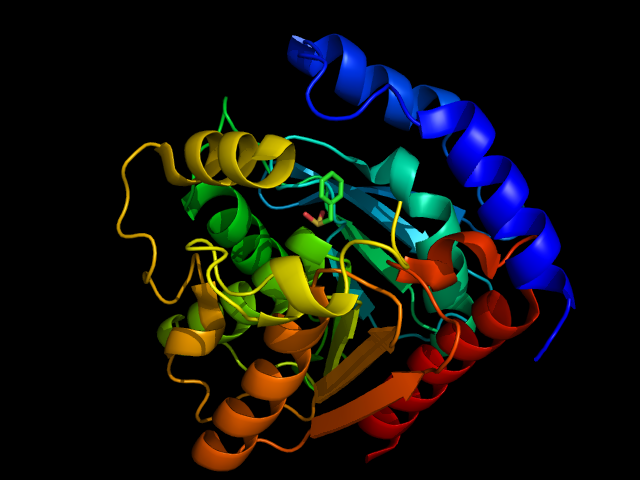Sandbox reserved 920
From Proteopedia
(Difference between revisions)
| Line 20: | Line 20: | ||
| - | Hormone-sensitive lipase can be inhibited by phenylmethylsufonyl flouride ([http://en.wikipedia.org/wiki/PMSF PMSF]) entering into the <scene name='58/580296/Meshligand/2'>active site</scene>. PMSF inhibits enzymes by binding to the SER residue of the serine protease active sites so that the normal catalytic activity cannot be carried out. This inhibitor will only bind to the active site SER because of its participation in the charge relay of the <scene name='58/580296/Meshligandinteraction/1'>catalytic triad</scene>. This hyper activity allows the sulfonyl group of PMSF to <scene name='58/580296/Inhibitorinteraction/4'>covalently bond</scene> to the SER residue to disrupt its activity. Because of this SER residue specificity, PMSF does not inhibit all kinds of lipases, just those dependent on SER residues in the active site. PMSF is highly degradable in aqueous solutions so it does not inhibit for very long periods of time in its natural environment. PMSF binding induces only a minor conformational change from the native protein.<ref name="Kanwar">PMID:23923547</ref> Inhibition or decreased activity of hormone-sensitive lipases can possibly lead to disorders such as obesity and type 2 diabetes. Inability to break down fatty acid molecules due to inactive hormone-sensitive lipases has been reported in many cases of obesity and type 2 diabetes. Increased inhibition of HSL by PMSF could, in theory, also be a possible cause of these diseases.<ref name="Kraemer">PMID: 12364542 </ref> | + | Hormone-sensitive lipase can be inhibited by phenylmethylsufonyl flouride ([http://en.wikipedia.org/wiki/PMSF PMSF]) entering into the <scene name='58/580296/Meshligand/2'>active site</scene>. PMSF inhibits enzymes by binding to the SER residue of the [http://proteopedia.org/wiki/index.php/Serine_Proteases serine protease] active sites so that the normal catalytic activity cannot be carried out. This inhibitor will only bind to the active site SER because of its participation in the charge relay of the <scene name='58/580296/Meshligandinteraction/1'>catalytic triad</scene>. This hyper activity allows the sulfonyl group of PMSF to <scene name='58/580296/Inhibitorinteraction/4'>covalently bond</scene> to the SER residue to disrupt its activity. Because of this SER residue specificity, PMSF does not inhibit all kinds of lipases, just those dependent on SER residues in the active site. PMSF is highly degradable in aqueous solutions so it does not inhibit for very long periods of time in its natural environment. PMSF binding induces only a minor conformational change from the native protein.<ref name="Kanwar">PMID:23923547</ref> Inhibition or decreased activity of hormone-sensitive lipases can possibly lead to disorders such as obesity and type 2 diabetes. Inability to break down fatty acid molecules due to inactive hormone-sensitive lipases has been reported in many cases of obesity and type 2 diabetes. Increased inhibition of HSL by PMSF could, in theory, also be a possible cause of these diseases.<ref name="Kraemer">PMID: 12364542 </ref> |
</StructureSection> | </StructureSection> | ||
==References== | ==References== | ||
<references /> | <references /> | ||
Revision as of 01:47, 1 April 2014
Your Heading Here (maybe something like 'Structure')
Anything in this section will appear adjacent to the 3D structure and will be scrollable. This is a default text for your page Sandbox reserved 920
Structure
| |||||||||||
References
- ↑ 1.0 1.1 Kanwar SS, Kaushal RK, Jawed A, Gupta R, Chimni SS. Methods for inhibition of residual lipase activity in colorimetric assay: a comparative study. Indian J Biochem Biophys. 2005 Aug;42(4):233-7. PMID:23923547
- ↑ 2.0 2.1 Kraemer FB, Shen WJ. Hormone-sensitive lipase: control of intracellular tri-(di-)acylglycerol and cholesteryl ester hydrolysis. J Lipid Res. 2002 Oct;43(10):1585-94. PMID:12364542

